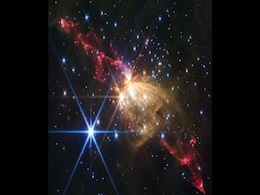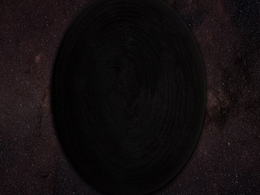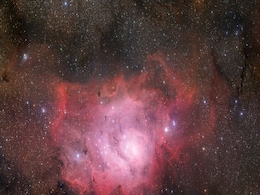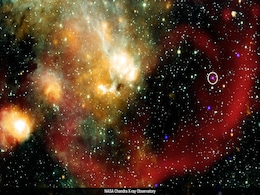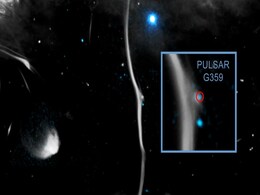Milky Way Star
- All
- News
-

NASA’s Nancy Grace Roman Space Telescope Surpassing Expectations Even Before Launch, Reveals Research
- Tuesday November 25, 2025
NASA’s upcoming Roman Space Telescope is expected to measure seismic waves in over 300,000 red giant stars, far greater than early predictions. These signals will help scientists better understand exoplanet systems and the Milky Way’s ancient core. Researchers say Roman’s natural survey design enables this breakthrough even before the telesco...
-
 www.gadgets360.com
www.gadgets360.com
-

Extreme Star Factory: ALMA Detects Galaxy Y1 Forming Stars 180 Times Faster Than the Milky Way
- Wednesday November 19, 2025
Using ALMA’s ultra-sensitive Band 9 observations, astronomers identified galaxy Y1 as an extreme star-forming system in the early universe. Producing stars at 180 solar masses per year, Y1 reveals how intense, short-lived starbursts helped shape young galaxies and may have been more common than previously believed.
-
 www.gadgets360.com
www.gadgets360.com
-

Scientists May Have Come Closer To Confirming Dark Matter's Existence, New Study Finds Clue
- Tuesday October 21, 2025
- Science |
The study notes that if excess gamma light is not from dying stars, it could become the first proof that dark matter exists.
-
 www.ndtv.com
www.ndtv.com
-

James Webb Telescope Unveils Hidden Star-Forming Regions in Sagittarius B2
- Wednesday October 1, 2025
New JWST observations reveal the hidden star-forming activity inside Sagittarius B2, the Milky Way’s largest molecular cloud. By seeing through dense dust, astronomers can study how stars form efficiently in extreme environments. These findings help explain not only Sgr B2 but also broader mechanisms shaping galaxies.
-
 www.gadgets360.com
www.gadgets360.com
-

James Webb Space Telescope Spots Rare Protostar Blasting Twin Jets Across Milky Way
- Friday September 12, 2025
NASA’s James Webb Space Telescope has captured a rare protostar about ten times the Sun’s mass blasting twin jets nearly eight light-years long. The beams carve through the glowing Sharpless 2-284 nebula, offering astronomers a vivid glimpse into how massive stars form and shape their galactic environment.
-
 www.gadgets360.com
www.gadgets360.com
-

Astronomers Discover Calvera, a Runaway Pulsar Racing Above the Milky Way
- Wednesday September 3, 2025
Astronomers have discovered Calvera, a pulsar speeding 6,500 light-years above the Milky Way’s disk. Formed from a supernova in a nearly empty region, Calvera challenges long-held ideas of star birth and death. Its discovery reveals that extreme stellar events can occur even in the galaxy’s sparse outer halo.
-
 www.gadgets360.com
www.gadgets360.com
-

Scientists See Insides Of Dying Star For The First Time
- Wednesday August 20, 2025
- World News | Associated Press
Scientists for the first time have spotted the insides of a dying star as it exploded, offering a rare peek into stellar evolution.
-
 www.ndtv.com
www.ndtv.com
-

Ursa Major III May Be a Star Cluster, Not a Dark-Matter Dwarf Galaxy
- Sunday August 24, 2025
Astronomers have long thought Ursa Major III, also called UNIONS 1, was a dark-matter-packed dwarf galaxy. But new simulations suggest it may instead be a compact star cluster bound by black holes and neutron stars. Located 30,000 light-years away, Ursa Major III contains just ~60 visible stars yet shows puzzlingly high stellar velocities. The new ...
-
 www.gadgets360.com
www.gadgets360.com
-

Massive 200-Light-Year Cloud May Be Channeling Matter to the Milky Way's Core
- Saturday August 2, 2025
Astronomers have discovered a massive, 200-light-year-wide cloud of gas and dust—dubbed the Midpoint cloud—hidden in the Milky Way. This giant molecular cloud appears to channel dense material into the galaxy’s core, possibly fueling star formation. The discovery offers rare insights into how matter flows from the galaxy’s disk to its turbu...
-
 www.gadgets360.com
www.gadgets360.com
-

Hubble Uncovers Multi-Age Stars in Ancient Cluster, Reshaping Galaxy Origins
- Saturday July 19, 2025
A stunning new image from NASA’s Hubble Space Telescope reveals that ancient star cluster NGC 1786—located 160,000 light-years away in the Large Magellanic Cloud—hosts stars of varying ages. Once believed to contain a single generation of stars, NGC 1786 now appears to preserve a more complex stellar history. This multi-age discovery suggests...
-
 www.gadgets360.com
www.gadgets360.com
-

Scientists Say Dark Matter Could Turn Failed Stars Into ‘Dark Dwarfs’
- Friday July 11, 2025
Astronomers suggest that brown dwarfs—dim, failed stars—could transform into “dark dwarfs” by capturing dark matter in their cores. When dark matter particles annihilate, they release heat, potentially lighting up these stars. Physicist Jeremy Sakstein and researchers like Jillian Paulin and Rebecca Leane support this idea, which could help...
-
 www.gadgets360.com
www.gadgets360.com
-

Astrophotographer Captures Stunning Portrait of Lagoon and Trifid Nebulas in Glowing Detail
- Wednesday June 18, 2025
Astrophotographer Greg Meyer captured a vivid 34-hour exposure of the Lagoon and Trifid nebulas glowing in the constellation Sagittarius. Framed beneath a dense starfield, the image reveals young stars sculpting gas and dust across 4,000 light-years. Taken from Arizona’s dark skies, the portrait offers a dazzling glimpse into stellar birth region...
-
 www.gadgets360.com
www.gadgets360.com
-

Astronomers Baffled By Mysterious Object Emitting X-Rays And Radio Waves In Milky Way
- Friday May 30, 2025
- Science |
The object, designated ASKAP J1832-0911, is located 15,000 light-years away and its nature is currently unknown, though it could be a highly magnetized dead star or something entirely new.
-
 www.ndtv.com
www.ndtv.com
-

New Study Confirms TeV Halos Are Common in Middle-Aged Pulsars
- Thursday May 22, 2025
A recent study by researchers from the U.S. and Mexico using data from the HAWC Observatory has confirmed that TeV halos are a universal feature of middle-aged pulsars. These extended regions of gamma-ray emission are significantly larger than pulsar wind nebulae and may help identify otherwise undetectable pulsars. The findings challenge existing ...
-
 www.gadgets360.com
www.gadgets360.com
-

NASA Reveals a Fracture in Huge Cosmic Bone: Everything You Need to Know
- Monday May 12, 2025
With the use of the Chandra X-Ray Observatory, NASA has detected a fracture in the Milky Way. The bone is a galactic center filament that is based at a distance of 26,000 light years from Earth. The fracture would have occurred due to collisions with the neutron star, known as a pulsar, that spins rapidly. The scientists suspect that the fracture w...
-
 www.gadgets360.com
www.gadgets360.com
-

NASA’s Nancy Grace Roman Space Telescope Surpassing Expectations Even Before Launch, Reveals Research
- Tuesday November 25, 2025
NASA’s upcoming Roman Space Telescope is expected to measure seismic waves in over 300,000 red giant stars, far greater than early predictions. These signals will help scientists better understand exoplanet systems and the Milky Way’s ancient core. Researchers say Roman’s natural survey design enables this breakthrough even before the telesco...
-
 www.gadgets360.com
www.gadgets360.com
-

Extreme Star Factory: ALMA Detects Galaxy Y1 Forming Stars 180 Times Faster Than the Milky Way
- Wednesday November 19, 2025
Using ALMA’s ultra-sensitive Band 9 observations, astronomers identified galaxy Y1 as an extreme star-forming system in the early universe. Producing stars at 180 solar masses per year, Y1 reveals how intense, short-lived starbursts helped shape young galaxies and may have been more common than previously believed.
-
 www.gadgets360.com
www.gadgets360.com
-

Scientists May Have Come Closer To Confirming Dark Matter's Existence, New Study Finds Clue
- Tuesday October 21, 2025
- Science |
The study notes that if excess gamma light is not from dying stars, it could become the first proof that dark matter exists.
-
 www.ndtv.com
www.ndtv.com
-

James Webb Telescope Unveils Hidden Star-Forming Regions in Sagittarius B2
- Wednesday October 1, 2025
New JWST observations reveal the hidden star-forming activity inside Sagittarius B2, the Milky Way’s largest molecular cloud. By seeing through dense dust, astronomers can study how stars form efficiently in extreme environments. These findings help explain not only Sgr B2 but also broader mechanisms shaping galaxies.
-
 www.gadgets360.com
www.gadgets360.com
-

James Webb Space Telescope Spots Rare Protostar Blasting Twin Jets Across Milky Way
- Friday September 12, 2025
NASA’s James Webb Space Telescope has captured a rare protostar about ten times the Sun’s mass blasting twin jets nearly eight light-years long. The beams carve through the glowing Sharpless 2-284 nebula, offering astronomers a vivid glimpse into how massive stars form and shape their galactic environment.
-
 www.gadgets360.com
www.gadgets360.com
-

Astronomers Discover Calvera, a Runaway Pulsar Racing Above the Milky Way
- Wednesday September 3, 2025
Astronomers have discovered Calvera, a pulsar speeding 6,500 light-years above the Milky Way’s disk. Formed from a supernova in a nearly empty region, Calvera challenges long-held ideas of star birth and death. Its discovery reveals that extreme stellar events can occur even in the galaxy’s sparse outer halo.
-
 www.gadgets360.com
www.gadgets360.com
-

Scientists See Insides Of Dying Star For The First Time
- Wednesday August 20, 2025
- World News | Associated Press
Scientists for the first time have spotted the insides of a dying star as it exploded, offering a rare peek into stellar evolution.
-
 www.ndtv.com
www.ndtv.com
-

Ursa Major III May Be a Star Cluster, Not a Dark-Matter Dwarf Galaxy
- Sunday August 24, 2025
Astronomers have long thought Ursa Major III, also called UNIONS 1, was a dark-matter-packed dwarf galaxy. But new simulations suggest it may instead be a compact star cluster bound by black holes and neutron stars. Located 30,000 light-years away, Ursa Major III contains just ~60 visible stars yet shows puzzlingly high stellar velocities. The new ...
-
 www.gadgets360.com
www.gadgets360.com
-

Massive 200-Light-Year Cloud May Be Channeling Matter to the Milky Way's Core
- Saturday August 2, 2025
Astronomers have discovered a massive, 200-light-year-wide cloud of gas and dust—dubbed the Midpoint cloud—hidden in the Milky Way. This giant molecular cloud appears to channel dense material into the galaxy’s core, possibly fueling star formation. The discovery offers rare insights into how matter flows from the galaxy’s disk to its turbu...
-
 www.gadgets360.com
www.gadgets360.com
-

Hubble Uncovers Multi-Age Stars in Ancient Cluster, Reshaping Galaxy Origins
- Saturday July 19, 2025
A stunning new image from NASA’s Hubble Space Telescope reveals that ancient star cluster NGC 1786—located 160,000 light-years away in the Large Magellanic Cloud—hosts stars of varying ages. Once believed to contain a single generation of stars, NGC 1786 now appears to preserve a more complex stellar history. This multi-age discovery suggests...
-
 www.gadgets360.com
www.gadgets360.com
-

Scientists Say Dark Matter Could Turn Failed Stars Into ‘Dark Dwarfs’
- Friday July 11, 2025
Astronomers suggest that brown dwarfs—dim, failed stars—could transform into “dark dwarfs” by capturing dark matter in their cores. When dark matter particles annihilate, they release heat, potentially lighting up these stars. Physicist Jeremy Sakstein and researchers like Jillian Paulin and Rebecca Leane support this idea, which could help...
-
 www.gadgets360.com
www.gadgets360.com
-

Astrophotographer Captures Stunning Portrait of Lagoon and Trifid Nebulas in Glowing Detail
- Wednesday June 18, 2025
Astrophotographer Greg Meyer captured a vivid 34-hour exposure of the Lagoon and Trifid nebulas glowing in the constellation Sagittarius. Framed beneath a dense starfield, the image reveals young stars sculpting gas and dust across 4,000 light-years. Taken from Arizona’s dark skies, the portrait offers a dazzling glimpse into stellar birth region...
-
 www.gadgets360.com
www.gadgets360.com
-

Astronomers Baffled By Mysterious Object Emitting X-Rays And Radio Waves In Milky Way
- Friday May 30, 2025
- Science |
The object, designated ASKAP J1832-0911, is located 15,000 light-years away and its nature is currently unknown, though it could be a highly magnetized dead star or something entirely new.
-
 www.ndtv.com
www.ndtv.com
-

New Study Confirms TeV Halos Are Common in Middle-Aged Pulsars
- Thursday May 22, 2025
A recent study by researchers from the U.S. and Mexico using data from the HAWC Observatory has confirmed that TeV halos are a universal feature of middle-aged pulsars. These extended regions of gamma-ray emission are significantly larger than pulsar wind nebulae and may help identify otherwise undetectable pulsars. The findings challenge existing ...
-
 www.gadgets360.com
www.gadgets360.com
-

NASA Reveals a Fracture in Huge Cosmic Bone: Everything You Need to Know
- Monday May 12, 2025
With the use of the Chandra X-Ray Observatory, NASA has detected a fracture in the Milky Way. The bone is a galactic center filament that is based at a distance of 26,000 light years from Earth. The fracture would have occurred due to collisions with the neutron star, known as a pulsar, that spins rapidly. The scientists suspect that the fracture w...
-
 www.gadgets360.com
www.gadgets360.com





